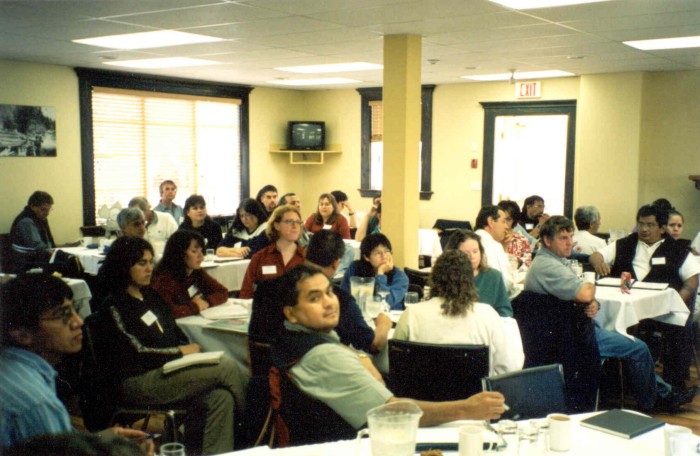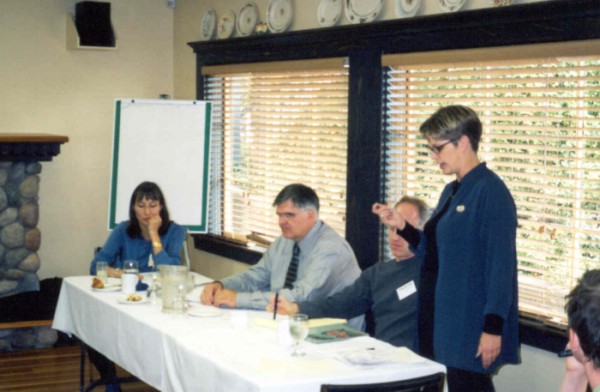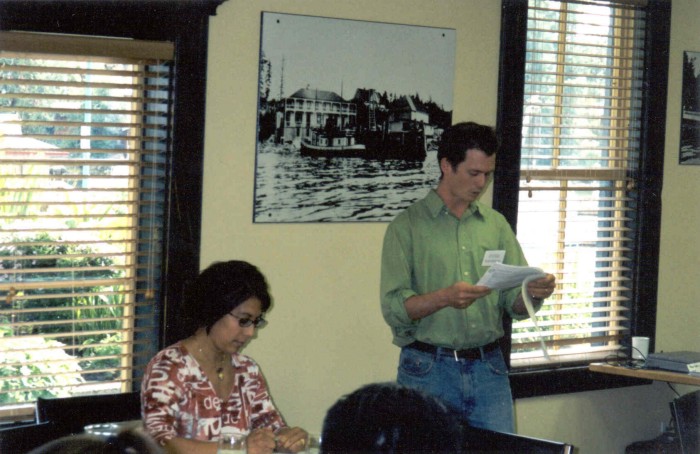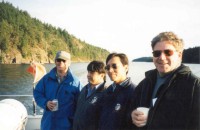Workshop Summary by Steven DeRoy
This workshop, held on October 3rd and 4th at the Lund Hotel in Sliammon Territory, was co-hosted by the Sliammon First Nation and Ecotrust Canada. The Primary goal of the workshop was to provide a forum for participants to share stories and learn about successful approaches for responding to and managing crown land referrals.
The first workshop relating to this topic was held almost 3 years earlier in November 1999. The workshop also followed the release of a new website produced by Ecotrust Canada and the Sliammon First Nation, Kla-soms Kwuth Tooqen – A Toolbox for responding to Crown Land Referrals (Click here). More than 50 people representing close to 30 First Nations, as well as 9 presenters comprised of lawyers, leaders and referrals practitioners attended the workshop. The location was amidst the beautiful scenery of the Sunshine Coast just north of Powell River.
|
|
What follows is my brief summary of the days events. In the next couple of weeks, I will be adding links to more detailed summaries of each of the presentations and speaking notes from some of the presenters.
The first day began with an opening prayer delivered by Eugene Louie, a Sliammon elder, along with a welcoming song and dance by Eric Blaney. Chief L. Maynard Harry took the opportunity to welcome all of the guests to Sliammon territory and to acknowledge the planning committee (Wendy de Bruin, Steven DeRoy and Ian Scott) who organized the workshop.
The first panel of speakers comprised of three lawyers who have been heavily involved with Aboriginal Law and how it relates to defending Aboriginal Rights and Title. Allan Donovan from Donovan and Company began speaking about recent successful litigation cases, the sources of consultation and the duty to consult. He also provided advice to the participants on how to be guided within the consultation process. This presentation was followed by numerous questions and comments.
Jack Woodward from Woodward and Company spoke next. He began by relating some of the points included in a publication he wrote titled “The End of False Consultation” and his conclusion that the Crown and resource industries are not innocent in their deliberate failure to consult with First Nations. He also spoke of the persistence made by Xeni Gwet’in who have been battling the Crown and Forest Industry to ensure First Nations Title is upheld. This precedent-setting trial begins on November 18th, 2002.
|
|
Everybody adjourned for a fulfilling lunch, followed by the eloquent words of Terri-Lynn Williams-Davidson who provided an inspiring keynote address regarding the work of the Haida to defend their Aboriginal rights and title on Haida Gwaii. She spoke of the forestry activities occurring on Haida Gwaii and the billions of dollars worth of forest resources that have been extracted by forest companies with limited benefits flowing to the Haida. She outlined how after many frustrating years trying to get government and the logging companies to change their practices, they felt compelled to launch their successful court case regarding the transfer of T.F.L. 39 from MacMillan-Bloedel to Weyerhaeuser. Terri-Lynn explained that the Haida are very confident that their historic title case will be successful, but it is going to require a lot of hard work. Their consistency and dedication has served the Haida well and they are determined to continue to defend Haida rights and title and have Haida interests accommodated.
Nancy Morgan from Morgan and Associates opened the afternoon session speaking about the need to have a focussed strategy when dealing with referrals and the importance for understanding exactly what your interests are. A way that this may be accommplished successfully is to develop a Land Use Plan for your territory. She recommended that it is imperative to be aware of the development proposals, their impacts and whether or not Aboriginal rights and title could be defended in the Court of Law. Evaluating the strength of your possible legal case allows you to determine how to approach each referral, especially when it presents serious concerns for your Nation. Nancy concluded her presentation by drawing attention to the paper she wrote for the Toolbox (The state of law on the obligation to consult with First Nations – August 2002).
The Hupacasath First Nation’s experience with the referrals process and the broad strategies they have implemented were presented by Tawney Lem. She spoke of the importance of capacity building, networking with other First Nations and building relationships with non-native neighbours. The Hupacasath have also worked to develop effective internal governance structures, consultation protocols and establish cultural heritage policies within their traditional territory.
|
|
Denise Smith from the Sliammon First Nation opened her presentation identifying the biggest challenges they have encountered – building capacity within their organization. She emphasized that First Nations people need to challenge the government to provide a clear answer to who within the bureaucracy decides whether Aboriginal rights are being impacted. She stipulated that First Nations people are working in conflict due to being pushed into living under a foreign government and need to continue to network and stay together.
As the first day of the workshop came to a close, participants were able to enjoy an incredible dinner and a boat cruise up into Desolation Sound, where we were treated to a beautiful sunset and magnificent backdrop of the mountain scenery. This was a great way to end a full day of presentations and relax in the company of fellow colleagues.
Day two of the workshop began with a presentation by Ian Scott from Ecotrust Canada. He introduced the recently-released “Kla-soms Kwuth Tooqen – a Toolbox for responding to Crown Land Referrals” website. This was followed by Chief L. Maynard Harry giving a summary of the lawyers discussions from the previous day.
The Sliammon Treaty Societies experiences over the past seven years was described by Roy Francis, negotiator for the Sliammon Treaty Society. Although he understands that the government won’t provide the full amount of compensation requested by the Sliammon, they need to approach the treaty settlement with a business perspective. They too have been building relationships with outside organizations and industry. He made it quite clear that the referrals work is extremely important to the success of his negotiations with the governments as it keeps the Nation advised of all the development that is taking place within the territory and identifies issues and opportunities.
Doug Hopwood, a registered professional forester working with Ecotrust Canada, made a presentation describing the various plans that would be reviewed by the referrals practitioner. The four main points for this presentation were 1) Look beyond the forest development plans; 2) Have a strategy and a vision; 3) Know what works; and 4) Understand that big changes are coming with the results-based Forest Practices Code that will eliminate the forest development plans as a forest management and review tool.
Cheri Ayers from the Hul’qumi’num Treaty Group gave a presentation based upon the consultation guidelines established by Robert Morales, their senior treaty negotiator. These guidelines identified their established four variables in determining the level of consultation, their overall strategy, the level of proposed infringement, the duty to consult, and their options for accommodation.
Following another great lunch, Chief L. Maynard Harry made a presentation regarding the successes, challenges, and advice he would give based on Sliammon’s experiences with Crown land referrals. He spoke of the training they have received, development conflicts within their territory, the fee-for-service rates Sliammon established for responding to referrals, and the challenges they have encountered with the province and the whole referrals process.
The final session of the day was an open-floor discussion with all of the participants who wanted to highlight their individual experiences that were successful. This opportunity for the participants to share their experiences was crucial to the success of the workshop as it opened doors for networking. As people were leaving the workshop, many of the participants told me they found the past two days to be informative and inspirational, and couldn’t wait for the next workshop to take place.
Click photos to see them in higher resolution:
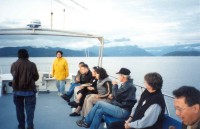 Dinner and a Cruise |
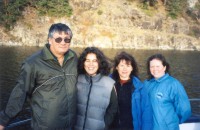 Dinner and a Cruise (left to right): Vic Clement, Claire Hutton, Cheri Ayers and Laurie Flahr |
|
|
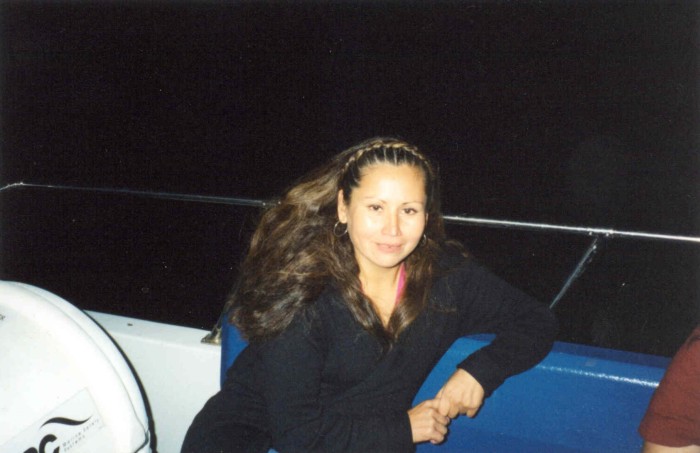 Dinner and a Cruise: Talitha Elliot |
 Dinner and a Cruise: Sliammon Territory
|
 Dinner and a Cruise: Sunset |


